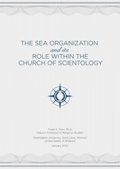As noted above, many religious traditions have resorted to spiritual disciplines in order to indoctrinate members into the higher stages of spiritual life or to correct the erring believer. Those disciplines historically have included such procedures as ecclesiastical inquiries, formal admonitions, judicial decisions, penances (prayer, fasting, silence, seclusion, physical labor, etc.), suspension, dismissals, and, as a last resort, expulsion and excommunication. Like most other religions the Church of Scientology has procedures for handling errant members. The procedures are contained in the various Policy Letters and Flag Orders issued by L. Ron Hubbard.
As a scholar of religions around the world I can attest that the methods of discipline in the Sea Org are standard and unexceptional religious practices. I can also attest that I myself experienced many similar disciplines when I was a member of the Order of Friars Minor (Franciscans) from 1958–64. The main forms of discipline deserve specific comment.
I can attest that the methods of discipline in the Sea Org are standard and unexceptional religious practices. I can also attest that I myself experienced many similar disciplines when I was a member of the Order of Friars Minor (Franciscans)...
Communications by Sea Org members with the outside society are far more extensive than those permitted under the rules of cloister practiced by many Christian religious orders and by Buddhist monks in Japan and elsewhere. Discalced Carmelites, for example, are forbidden all contact with the outside world after they freely enter the order. When I went through novitiate (the first year entry) in the Order of Friars Minor I had minimal contact with the outside world and that only with explicit permission of my novice master. At times when members of religious orders go on spiritual retreats they are secluded from worldly contact. Religious orders of nuns such as the Poor Clares severely restrict access to the member of the order even by family members, who are allowed to visit only three or four times a year and whose visits are limited to two hours at the most. Cloistered nuns can have no direct physical contact with family members and must speak with them through obscuring screens. Furthermore, Catholic errant members of religious orders and of the clergy, including those who fall prey to alcohol and drugs, are sent into retiro, or rehabilitative seclusion, until such time as they are healed and can resume their duties. To the extent that Sea Org members undergo limited seclusion from the world during a rehabilitative period accords with general religious practice throughout the world.
The rules of all Christian religious orders require that the monks, friars, brothers and nuns take vows of obedience, and a spiritual demeanor of humility is central to that vow. In order to practice humility, members of religious orders are frequently required to perform lowly tasks and physical labor that would appear demeaning and degrading to outsiders. As a Franciscan friar in training to become a priest, I cleaned latrines, peeled potatoes, hoed the garden, pulled weeds from sidewalk cracks, washed and folded laundry, and swept corridors. One can find exhortations to humility in the Rule of St. Benedict, Chapter 7. The Benedictine spiritual motto is Ora et labora (“Pray and do physical labor!”) and that includes the most humble tasks equally for the lowliest of novices to the most exalted of abbots. In Japanese Zen Buddhist monasteries those who aspire to satori (enlightenment) are often required by their spiritual masters to perform repetitive and seemingly utterly meaningless tasks, such as sweeping a spotlessly clean floor over and over again. The fact that members of the Sea Org, who take vows of service for a billion years, may be required to perform physical labor and menial and even humbling tasks, particularly as part of a period of rehabilitation or discipline, comes as no surprise to any scholar of religion.
Those in the monastic life, like the Cistercians and Trappists, often keep late night vigils, sleeping as little as three or four hours a night. During these vigils, the monks do ritual chanting and silent meditation. I lived this way for six years as a friar. During my novitiate year, I rose during the night at 12:30 a.m., chanted psalms for one hour, meditated for another hour, returned to bed, and rose for prayer again at 7:30 a.m. for more chanting and morning Mass. It is standard practice for Trappists to rise at 3:15 a.m. communal prayer and meditation. Many monks and nuns undertake even painful disciplines such as flagellation of the body on Fridays in commemoration of the flagellation of Jesus before his crucifixion. Eastern yogis even go to the extent of piercing the body with nails to demonstrate the mastery of the spirit over matter. Besides these spiritual disciplines, the practices of the Church of Scientology pale in comparison.
Members of different religious orders are often “locked in” at night and put under “surveillance” without being “imprisoned”. Monasteries and nunneries in the United States and throughout the world are locked at night. Cloistered sections in nunneries of the Discalced Carmelites and Poor Clares are even sealed off by secondary gates and barriers. When novices undergo training and when errant monks and nuns are placed under restriction, they are closely supervised, kept under constant surveillance and even restricted to certain parts of the monastery itself. I experienced firsthand restriction and surveillance. The aim of restriction is to cut off the religious person from the distractions of the world so that they may attain spiritual light or reform errant ways.
As noted above, Scientology is not alone in seeking to excommunicate members who are unwilling to undergo the examinations, and ecclesiastical trials and procedures, and disciplines to regain full standing as a Church member. The Roman Catholic Church has a similar set of procedures for schismatic, heretical or otherwise aberrant members which are codified in the Code of Canon Law. Many Pietist Brethren churches such as the Amish and the Old Order Mennonites practice a form of ecclesiastical excommunication called “banning” or “shunning”. Excommunicates are completely cut off from the faith community and members are not allowed even to have business dealings with the shunned party. Futhermore, a spouse is prohibited from cohabiting with a banned partner.
In Scientology, Sea Org members, because of their greater commitment to the aims and goals of the religion, have historically been expected to live a more abstemious life than ordinary members. Some Christian religious orders, generally known as “monks” like the Benedictines and Cistercians, take vows of personal poverty, while the monastery may own buildings for prayer, study and worship and lands for tilling. Other religious orders, generally known as “friars” such as the Franciscans and Dominicans, take vows of absolute poverty, that is, they are not allowed to own anything as individuals or as a group in imitation of Jesus who possessed nothing. Friars have only the use of property; the real owner is the papacy. A Trappist monk lives in a bare cell, sleeps on a straw mattress with bare boards underneath, and possesses two habits and a set of work clothes. When I was a friar I performed many useful tasks, including teaching philosophy, working as a librarian, running a print shop, and doing outside buying for the friary. For this labor I received absolutely no wages other than room and board and the habit on my back. I had no money to go to movies, to shop outside for personal things, or to eat out on occasion. When I left the friary after six years I was given the sum of $500.00, a plane ticket and a suit. Compared to the practices of many other religious orders, the lifestyle and monetary arrangements in the Church of Scientology are, if anything, generous.
The fact of conflict between converts and their natal families and even first spouses is as old as religion itself. It was Jesus himself who said: “For I have come to set a man against his father and a daughter against her mother” (Matthew 10:35); and “Whoever loves father and mother more than me is not worthy of me; and whoever loves son or daughter more than me is not worthy of me” (Matthew 10:37). The cost of discipleship can be very high. Both St. Francis of Assisi and St. Thomas Aquinas, two of the most significant figures and saints in Catholicism, were kidnapped by their families, who tried to force them out of their way of life in their respective mendicant (“beggar”) orders. Separation from family is a normal practice in monastic life both for men and for women. Trappists, Carmelites, and Cistericians sometimes sever all ties with the outside world, including phone calls, mail, and visits. Hermits on Mt. Athos in Greece live in complete solitude and often do not even associate with fellow monks and hermits. When I was a Franciscan and doing my novitiate year, I could not speak with anyone outside the friary walls without explicit permission, I could receive one letter a month from my parents only, my mail was subject to perusal by the novice master and I was not allowed to attend the funeral of my grandfather. In First Corinthians 7:15, the Apostle Paul recommends that a converted woman be allowed to divorce and remarry in the faith if her first husband remains hostile to the faith. As noted above in para. 28, the Rule of St. Benedict threatens excommunication to any brother who associates with another excommunicated monk without the approval of the abbot lest such contact contaminate the brother’s spiritual life. The Old Order Mennonites and Amish require a spouse to shun the other if the latter has been put under the ban. Siddartha Gautama (ca. 563–483 B.C.E.), known to us as the Buddha, felt compelled to abandon father and mother, wife and children, and throne and dominion in order to pursue the path of enlightenment as an ascetic. The story of nearly every great conversion in religious history contains a theme of separation from a prior lifestyle and ties to worldly things, including family, that may retard or thwart spiritual progress. In comparison, Sea Org members’ contacts with the outside world are moderate to liberal.





























